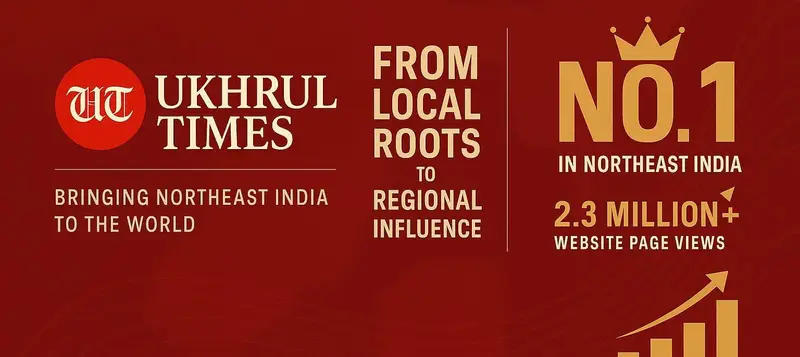Now Reading: CHAGA NGEE festival of the Liangmai community
-
01
CHAGA NGEE festival of the Liangmai community
CHAGA NGEE festival of the Liangmai community

THE ONSET of autumn heralds the arrival of a much awaited festival – Chaga Ngee for the Liangmai community of Northeast India. Celebrated annually on the 30th of October (Chagahiu), it is a festival having an immense religious and traditional significance. Chaga Ngee was declared a restricted state holiday by our present Chief Minister, N Biren Singh in December, 2021.
For Liangmai context, Chagahiu (October) is the month of festival. It can be termed as the blessed month. It is a festival of thanksgiving and sanctification. Chaga Ngee is the biggest and the most important festival of the Liangmai community. In today’s time, folk dances, traditional dress display with magnificent designs and war cries is the core theme of the festival.
Also read | First Clean Village Festival of Mapao Zingsho village begins
In olden days, Chaga Ngee was a five-day celebration. It was during those times when Liangmais considered nature or the entire universe as their sacred scripture. A profound relationship between gods, creations and humans constitutes the whole reality of the Liangmai worldview. The festival began with the preparation of jou thoubo which means pounding of rice for brewing beer. The second day was for jou madungbo, meaning leavening the rice beer. The third day was called chami malapbo nai, where the priest started the fire by rubbing bamboo against dry wood. The Liangmais laid great stress for omens with the new fire, and they extinguished the old fire in every household hearth. The new fire was rekindled by male member and was taken to their homes. This act signifies a new phase of life in the village. During these days, all married men and women abstained from a sexual relationship. Moreover, it was taboo to be sick, injured or bed ridden. On the fourth day was peng kepbo where every male participated in shooting a human effigy with an arrow or sharp object. It was an auspicious act to test one’s luck and fortune. If the person hit the head, he was destined to be a great warrior. If one hit the chest, many lovers would he have. Hitting the stomach means a rich harvest. And if the arrow hit the lower part of the waist, adversity followed the thrower. After everyone had their try, they chanted in unison to fulfil the good fortunes and prayed for God’s blessings for the next year. The fifth day was called chaga pahbo, which was the end of the festival. It was followed by a grand feast, merry making, war cries and dances to the tune of drums, gongs and cymbals. Competitions were also held mainly in preparation for the war.
Nagaland | Late Professor Temsula Ao, a larger-than-life figure: Naga Scholars’ Association
The splendour of rich and exclusive heritages was revived on Chaga Ngee, adding a rejuvenating touch to the already beautiful and fresh mountains, rivers and lands of the Liangmai villages.
For good or for bad, Christianity had indeed played an integral part in altering the socio-cultural life of the Liangmais. Modernity is a by product of British colonization and Christian missionization. The breakdown of traditional systems marked the beginning of socio cultural alterations and drastic readjustment. In one way, it was a watershed moment because there was a radical introduction of far reaching modifications of the whole scenario. Religion was polytheistic with more ritualistic practices and drowned with superstitions. The postmodern Liangmai community is a heterogeneous one – a mixture of tradition and modernity, relational multitudes, synthesis of Christian values and traditional worldview.
There was gradual yet drastic collective introspection and awakening experiences in every aspect of life.
Community, society and culture change depending on the spatial and temporal trends. The present day celebration of Chaga Ngee is one such example. It is no longer a 5-day celebration, instead the festival is of one day. Also, it used to be held in every village annually and today, the community come together in one venue to celebrate the blessed festival. It has evolved through time with the influence of other cultures of the world. One can underline that it is an expressive way to keep alive the glorious heritage, culture and traditions. It is also worth remembering that nothing brings people together like festivals do. Chaga Ngee contributes immensely in knitting the social cohesion. People’s attention is diverted from their demanding lives and amuse them with plethora of activities related with cultural or ethnic topics.
Editorial | Ballboy to Legend: A tribute to Roger Federer
It is a delightful time to relish traditional arts, aestheticism, heritages blended with old and new, tradition and modernity. The sight of men and women, young and old dressed in colourful traditional dresses in large number with hornbill feathers, headgears and spears is spellbinding. Celebrating with true intent and spirit – Chaga Ngee serves as a significant tool to spread message of love, peace and unity in the state, region and beyond.
Sanwibo Chaga Ngee to all! Alik-lik-lik-lik-oh-oh-oh!
Khiubamliu Chawang can be reached at diphiu2329@gmail.com














